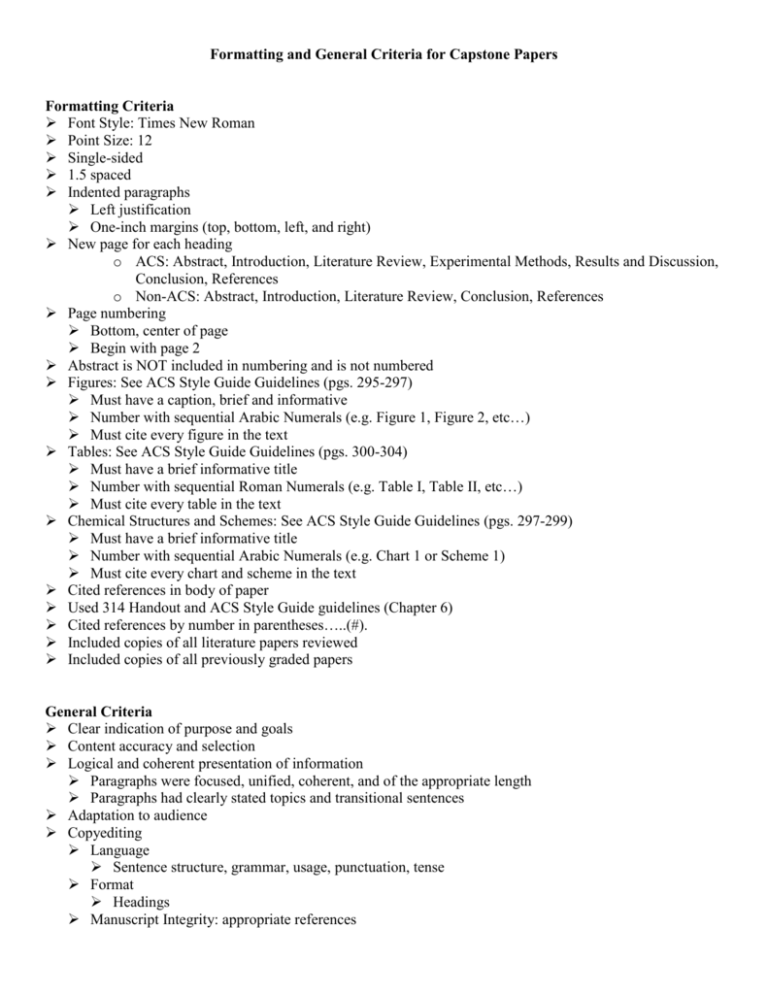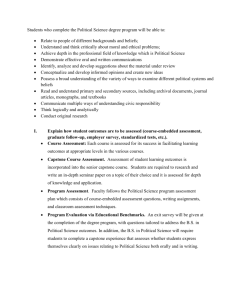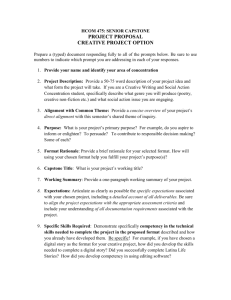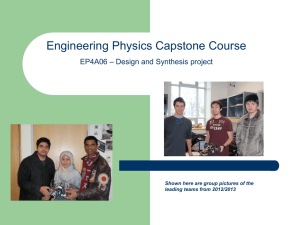Ch 314 2005 Final Exam: Oral Presentation
advertisement

Formatting and General Criteria for Capstone Papers Formatting Criteria Font Style: Times New Roman Point Size: 12 Single-sided 1.5 spaced Indented paragraphs Left justification One-inch margins (top, bottom, left, and right) New page for each heading o ACS: Abstract, Introduction, Literature Review, Experimental Methods, Results and Discussion, Conclusion, References o Non-ACS: Abstract, Introduction, Literature Review, Conclusion, References Page numbering Bottom, center of page Begin with page 2 Abstract is NOT included in numbering and is not numbered Figures: See ACS Style Guide Guidelines (pgs. 295-297) Must have a caption, brief and informative Number with sequential Arabic Numerals (e.g. Figure 1, Figure 2, etc…) Must cite every figure in the text Tables: See ACS Style Guide Guidelines (pgs. 300-304) Must have a brief informative title Number with sequential Roman Numerals (e.g. Table I, Table II, etc…) Must cite every table in the text Chemical Structures and Schemes: See ACS Style Guide Guidelines (pgs. 297-299) Must have a brief informative title Number with sequential Arabic Numerals (e.g. Chart 1 or Scheme 1) Must cite every chart and scheme in the text Cited references in body of paper Used 314 Handout and ACS Style Guide guidelines (Chapter 6) Cited references by number in parentheses…..(#). Included copies of all literature papers reviewed Included copies of all previously graded papers General Criteria Clear indication of purpose and goals Content accuracy and selection Logical and coherent presentation of information Paragraphs were focused, unified, coherent, and of the appropriate length Paragraphs had clearly stated topics and transitional sentences Adaptation to audience Copyediting Language Sentence structure, grammar, usage, punctuation, tense Format Headings Manuscript Integrity: appropriate references Fall 2010 Requirements for Experimental Research Capstone Papers Emphasis of papers should be placed on items italicized below Abstract Summarized the information presented in the paper Clearly identified the topic/research to be discussed Established the experimental methods employed Summarized results and their importance Introduction Re-identified the topic to be discussed Established the scope of the project Presented relevant background or contextual material (i.e. theoretical or historical) Literature Review Developed topic by adding details such as -Theoretical issues, Techniques used for study, Applications Defined unfamiliar terms and/or techniques Included figures/tables to clarify or enhance topic Included balanced chemical equations if necessary Analyzed, explained and evaluated topic/work described Reviewed and updated literature review Experimental Methods Clearly described the experiments conducted Results and Discussion Clearly presented the data Clearly and thoroughly analyzed and discussed the results Conclusion Summarized topic/work discussed in body Presented future experiments to be conducted References Typically between 5-10 references Including a literature review paper Fall 2010 Requirements for Literature Research Capstone Papers Emphasis of papers should be placed on items italicized below Abstract Summarized the information presented in the paper Clearly identified the topic/research to be discussed Established the experimental methods employed in papers reviewed Summarized results and their importance Introduction Re-identified the topic to be discussed Established the scope of the project Presented relevant background or contextual material (i.e. theoretical or historical) Literature Review Developed topic by adding details such as -Theoretical issues, Techniques used for study, Applications Defined unfamiliar terms and/or techniques Included figures/tables to clarify or enhance topic Included balanced chemical equations if necessary Analyzed, explained and evaluated topic/work described Reviewed and updated literature review Experimental Methods Clearly described the pertinent experiments presented in the papers Results and Discussion Clearly described the data reported in the papers Clearly and thoroughly discussed the results Conclusion Summarized topic/work discussed in body Presented future areas to be reviewed References Typically between 8-12 references Including a literature review paper 2010-2011 Literature Research Capstone Projects What will I do for my project? Unless you have arranged an alternative with a member of the chemistry faculty, you will write a critical review of some area of current research, and give an oral presentation of your paper. How will I know what topic to write about? You may write on the same topic you addressed in Ch 316 or you may select a new topic. This paper will go into greater depth, demonstrating, among other things, an understanding of the details of the experimental work. Who is my faculty advisor? You will have the same advisor you had in Ch 316, unless there is a valid reason to make a change. Are there things I need to do if I’m doing an external internship rather than writing a paper? Yes, there is paperwork to fill out. See Dr. Hughes to get the proper forms. If you are interested in finding an internship, she has a list of places that have worked with students in the past. How will I be graded in Ch 497? Your faculty advisor will assign your grade. The course must be taken for an A-F grade, and incompletes will not be given to anyone. It is possible to fail this course, which can delay your graduation by a year! Your grade in Ch 497 will be based upon the quality of your written report and oral presentation, and your attendance at class meetings. 2010-2011 Experimental Research Capstone Projects What will I do for my project? If you don’t know the answer to this, you’ve got an immediate problem. You should have worked this out last year. Who is my faculty advisor? See answer to question above. What will I do this term? Mostly you will work on your project, trying to get some results. In addition, you will write a report and give an oral presentation detailing your efforts. If you haven’t gotten started, you are already behind. Get moving! How will I be graded in Ch 497? Your faculty advisor will assign your grade. The course must be taken for an A-F grade, and incompletes will not be given to anyone. Students will receive one credit hour for Ch 497 and are expected to put forth the equivalent of 3 hours effort towards this course. Your grade in Ch 497 will be based upon your effort in lab, the quality of your capstone lab notebook, written report and oral presentation, and your attendance at class meetings. Optional: Registering for Additional Research Credit Hours Based upon the advice and consent of your faculty advisor, you may register for additional research credit hours (maximum of 2 credit hours per term). For every credit hour of Ch 401 that a student registers for, they will be expected to complete a minimum of 3 hours in the lab. What if I did my experimental work over the summer? You will follow the same schedule, giving the same talks and writing the same papers, but won’t be doing any lab work. Grade Profiles for Chemistry Capstone Projects Students who receive grades of A work on their projects regularly, and make good use of their time. They come to lab with a good idea of what they hope to accomplish, and know what things need to be clarified before beginning work. Although not reluctant to ask for advice, they make an effort to analyze their results and plan their future activities. They contribute their own ideas for the improvement of the research project. They show initiative in setting up experiments and using appropriate instruments. They develop significant technical expertise appropriate to their project. They maintain an organized, detailed laboratory notebook which is easily understood by others. They meet with their faculty mentors regularly to explain what they have accomplished and to plan future experiments. At the end of the term they write a clear, detailed report describing and analyzing their results, which would allow another student to repeat their work. Although they fit their research into the appropriate context of their lives, they are more concerned with making progress than with watching the clock. Although their final results are subject to the vagaries of nature, it is clear that they put forth an outstanding effort towards their problem. Students who receive grades of B work on their projects regularly, and make good use of their time. They come to lab with a good idea of what they hope to accomplish, and know what things need to be clarified before beginning work. They consult frequently with their faculty mentor, on whom they are largely dependent for data analysis and planning. They capably set up experiments and use appropriate instruments as directed by their mentor.. They develop adequate technical expertise appropriate to their project. They maintain an organized, detailed laboratory notebook which is easily understood by others. They meet with their faculty mentors regularly to explain what they have accomplished and to plan future experiments. At the end of the term they write a clear, detailed report describing and analyzing their results, which would allow another student to repeat their work. They fit their research into the appropriate context of their lives, and put in enough effort to make progress suitable for a respectable final presentation. Students who receive grades of C work on their projects somewhat irregularly, and often use their time in an unproductive and disorganized manner. They often come to lab without having thought through their plans, and are consequently highly dependent upon their faculty mentor to tell them what to do. They generally leave data analysis and planning to the faculty. They set up experiments and use appropriate instruments as directed by their mentor, but frequently need help to obtain adequate results. They fail to become expert at technical tasks, even through repetition. They maintain a laboratory notebook which does not contain a legible or complete record of their work. They meet with their faculty mentors infrequently. At the end of the term they write a report which would probably not allow another student to repeat their work. They place the research project low on their priorities, and although they put in enough time to get something accomplished, a successful outcome is of secondary importance. The final result is adequate to prevent serious embarrassment. Students who receive grades of D work on their projects irregularly, and use their time in an unproductive and disorganized manner. They come to lab without having thought through their plans, and are consequently highly dependent upon their faculty mentor to tell them what to do. They leave data analysis and planning to the faculty. They attempt to set up experiments and use instruments as directed by their mentor, but need help to obtain adequate results. They fail to become expert at technical tasks, even through repetition. They do not maintain a legible or complete record of their work. They meet with their faculty mentors infrequently, often avoiding contact with them. At the end of the term they write a disorganized report which fail to convey the essence or the details of the project. They place the research project low on their priorities, and do not spend enough productive time to accomplish much. They demonstrate little genuine interest in the research project. The final result is an embarrassment to the student. Students who receive grades of F generally know why. Note: No incompletes will be assigned for CH 497/498/499. Any student who fails to pass 497/498/499 will have to re-take the course the following year.






